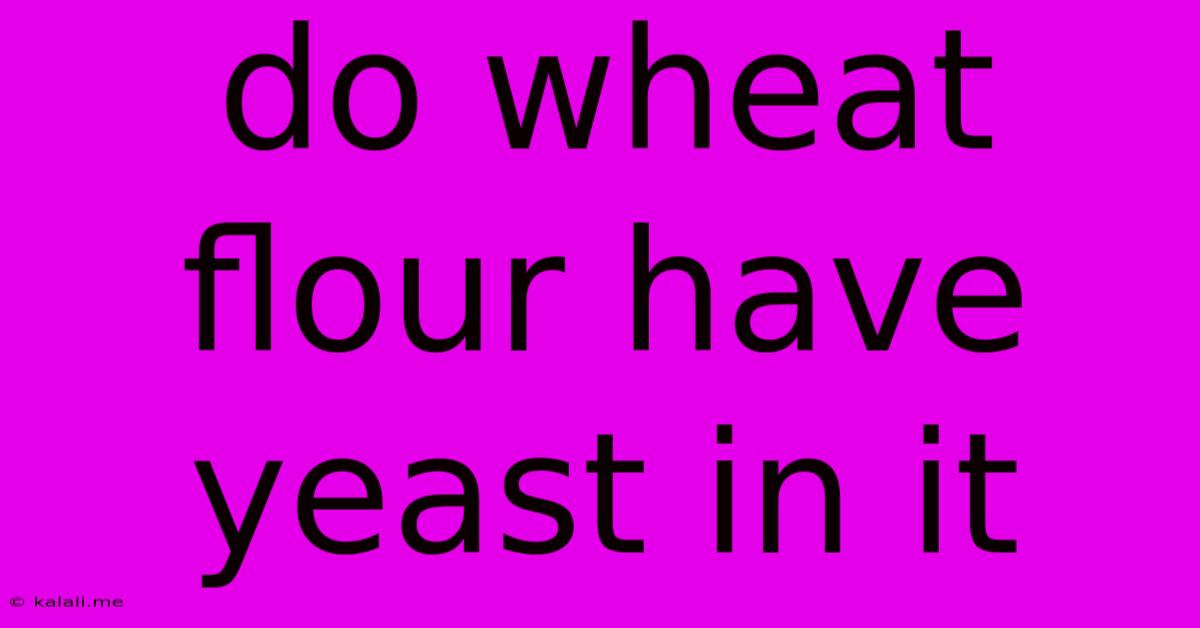Do Wheat Flour Have Yeast In It
Kalali
Jun 06, 2025 · 2 min read

Table of Contents
Does Wheat Flour Have Yeast in It? Unpacking the Baking Basics
So, you're ready to bake, but a crucial question arises: does wheat flour contain yeast? The short answer is no, plain wheat flour does not contain yeast. This article will delve deeper into the relationship between flour, yeast, and the baking process, clarifying common misconceptions. Understanding this fundamental difference is key to successful baking.
Wheat flour, the primary ingredient in many baked goods, is simply ground wheat kernels. It provides the structure and texture to breads, cakes, and pastries. Yeast, on the other hand, is a single-celled fungus crucial for the leavening process – that is, the rising of dough. Yeast consumes sugars in the flour and produces carbon dioxide gas, causing the dough to expand and become light and airy.
The Role of Yeast in Baking
Yeast is a living organism that requires specific conditions to thrive: warmth, moisture, and food (sugars). When added to flour, water, and other ingredients, yeast begins to ferment, producing the gas that leavens bread. This is why bread dough rises. Without yeast (or another leavening agent like baking powder or baking soda), you'll end up with a flat, dense product.
Different types of flour, such as all-purpose flour, bread flour, and cake flour, are all essentially yeast-free. These flours provide the fundamental components for baking but require the addition of yeast (or alternative leavening agents) for the desired rise and texture.
Self-Rising Flour: A Notable Exception
While plain wheat flour doesn't contain yeast, it's important to mention self-rising flour. This type of flour does contain added leavening agents, typically baking powder and salt. Baking powder provides the necessary lift, mimicking the effect of yeast, but through a chemical reaction rather than fermentation. Self-rising flour is convenient for quick breads and biscuits, but isn't suitable for all recipes.
It's crucial to check the ingredients list on your flour packaging to be sure of what you're using. This will help you avoid mistakes in your baking, ensuring you're adding the right leavening agent for your chosen recipe.
Understanding Leavening Agents
To summarize, understanding the difference between yeast and flour is essential for successful baking. While many recipes utilize yeast for a light and airy texture, the flour itself does not contribute to this leavening process. Here's a quick comparison of common leavening agents:
- Yeast: A living organism that requires fermentation for leavening. Best for breads.
- Baking powder: A chemical leavening agent, providing immediate lift. Best for cakes and quick breads.
- Baking soda: Another chemical leavening agent, requiring an acidic ingredient to activate. Often used in combination with baking powder or in recipes with acidic ingredients like buttermilk.
Therefore, if your recipe calls for yeast, you’ll need to add it separately to your flour mixture. Knowing the role of each ingredient ensures you'll create delicious and perfectly textured baked goods every time.
Latest Posts
Latest Posts
-
What Voltage Is A Cigaret Lighter In A Car
Jun 06, 2025
-
Equation Relating Gravitational Force And Buoyant Force
Jun 06, 2025
-
How To Get Dried Paint Off Wood Floors
Jun 06, 2025
-
For A Lack Of A Better Word
Jun 06, 2025
-
Why Is A Penthouse Called A Pent House
Jun 06, 2025
Related Post
Thank you for visiting our website which covers about Do Wheat Flour Have Yeast In It . We hope the information provided has been useful to you. Feel free to contact us if you have any questions or need further assistance. See you next time and don't miss to bookmark.